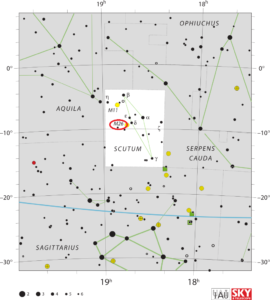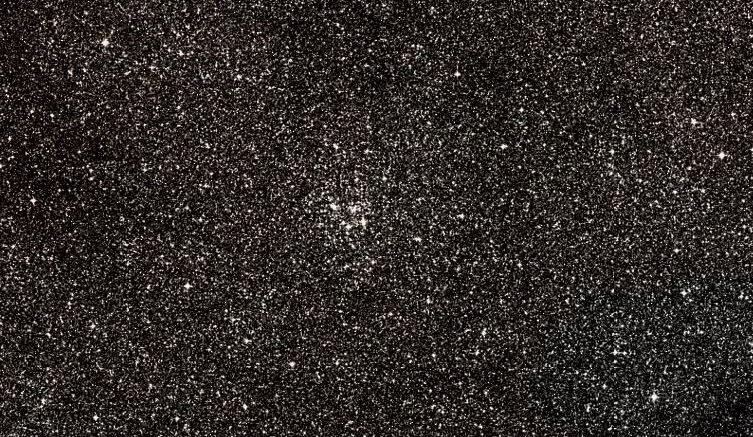An interesting feature of Messier 26 is a region of low star density near the nucleus. A hypothesis was that it was caused by an obscuring cloud of interstellar matter between us and the cluster. Nevertheless, Messier 26, also known as NGC 6694, is an open cluster of stars in the southern constellation of Scutum. It was discovered by Charles Messier on June 20, 1764. This 8th magnitude cluster is a challenge to find with typical binoculars, but can be spotted with an 80mm aperture.
| Description | |
| Visible From Pacific Northwest | June To September |
| Best Time To Observe | August |
| Minimum Size Of Viewing Device | 10×50 Binoculars |
| Object Type | Open Cluster |
| Designations | Messier 26, M26, NGC 6694, Collinder 389, C 1842-094, OCl 67, MWSC 2987, h 3758 |
| Right Ascension | 18h 45.2m |
| Declination | -09°24′ |
| Constellation | Scutum |
| Number Of Stars | 90 |
| Apparent magnitude | +8.0 |
| Apparent dimensions | 15′ |
| Object Radius | 11 light years |
| Distance From Earth | 5,000 light years |
History
Charles Messier discovered the cluster on June 20, 1764. He described it as a “cluster near Eta and Omicron in Antinous [now Alpha and Delta Scuti], between which there is another one of more brightness: with a telescope of 3.5-foot [FL] one cannot distinguish them, one needs to employ a good instrument. This cluster contains no nebulosity. (diam. 2′)”
In his entry in the first Messier catalogue (1771), he wrote:
In the same night [June 20 to 21, 1764], I discovered another cluster of stars near n & o of Antinous, among which there is one which is brighter than the others: with a refractor of three feet [FL], it is not possible to distinguish them, it requires to employ a strong instrument: I saw them very well with a Gregorian telescope which magnified 104 times: among them one doesn’t see any nebulosity, but with a refractor of 3 feet & a half, these stars don’t appear individually, but in the form of a nebula; the diameter of that cluster may be 2 minutes of arc. I have determined its position with regard to the star o of Antinous, its right ascension is 278d 5′ 25″, & its declination 9d 38′ 14″ south.
Locating M26 In The Sky
M26 lies only a degree to the southeast of Delta Scuti, a peculiar giant star with the spectral classification F2, that serves as a prototype for a class of pulsating variable stars known as the Delta Scuti variables. The star has an average visual magnitude of 4.71. It is one of the two relatively bright, naked-eye stars near M26. The other star, Epsilon Scuti, has an apparent magnitude of 4.88 and lies slightly north of Delta Scuti. Messier 26 can also be found by first locating the bright Altair in the constellation Aquila and extending the line formed by the stars that mark the celestial eagle’s back in the direction of the Teapot in Sagittarius.

Viewing M26
The cluster is not visible to the naked eye, but will appear as a compression of stars in 10×50 binoculars. Small telescopes will reveal a compact star cluster, and 6-inch and 8-inch telescopes will resolve about 25 brightest stars.
Photographing M26
There are many different blogs and write-ups for imaging M26, with each providing their own details and perspectives. We will be dropping those links below, but it looks like this is indeed a popular target for amateur astronomers. To capture M26 in images, utilize a CMOS or filtered DSLR camera with auto guiding. The key is to have precise guiding as only about 1 hours worth of data is required with exposure time being about 30 second per image.
Sources And Further Reading
Descriptions of all of Messier Objects can be found here.
https://freestarcharts.com/messier-26

Please tell me that youre going to keep this up! Its so excellent and so important. I cant wait to read far more from you. I just feel like you know so very much and know how to make people listen to what you might have to say. This weblog is just too cool to become missed. Good stuff, seriously. Please, PLEASE keep it up!